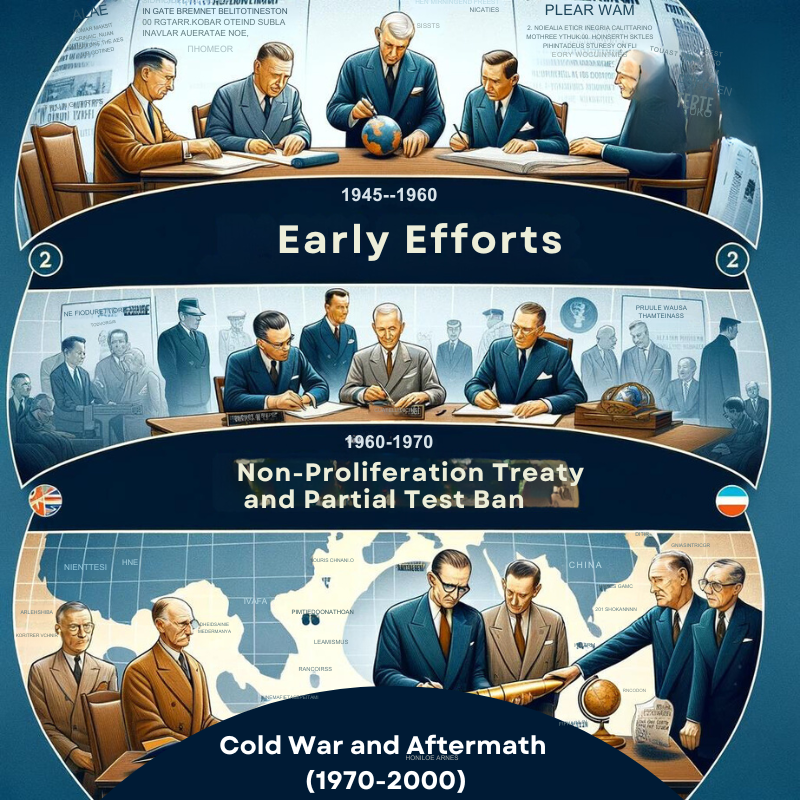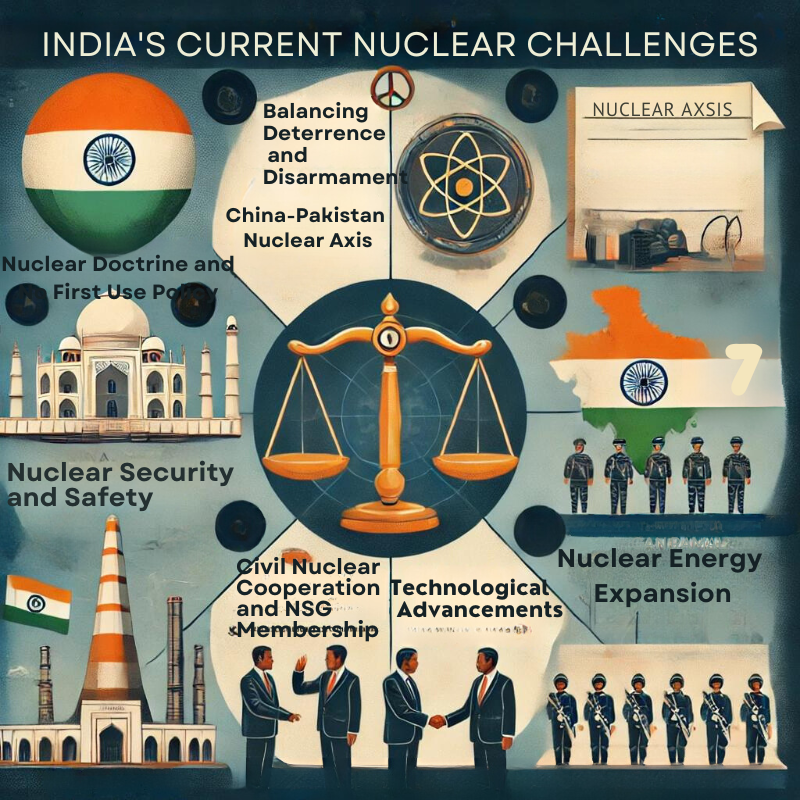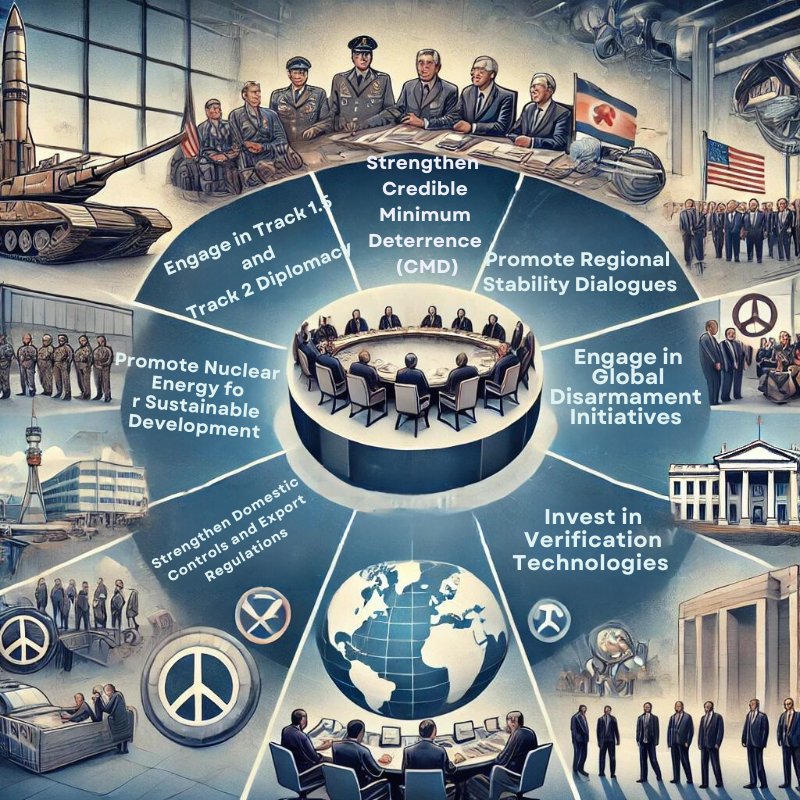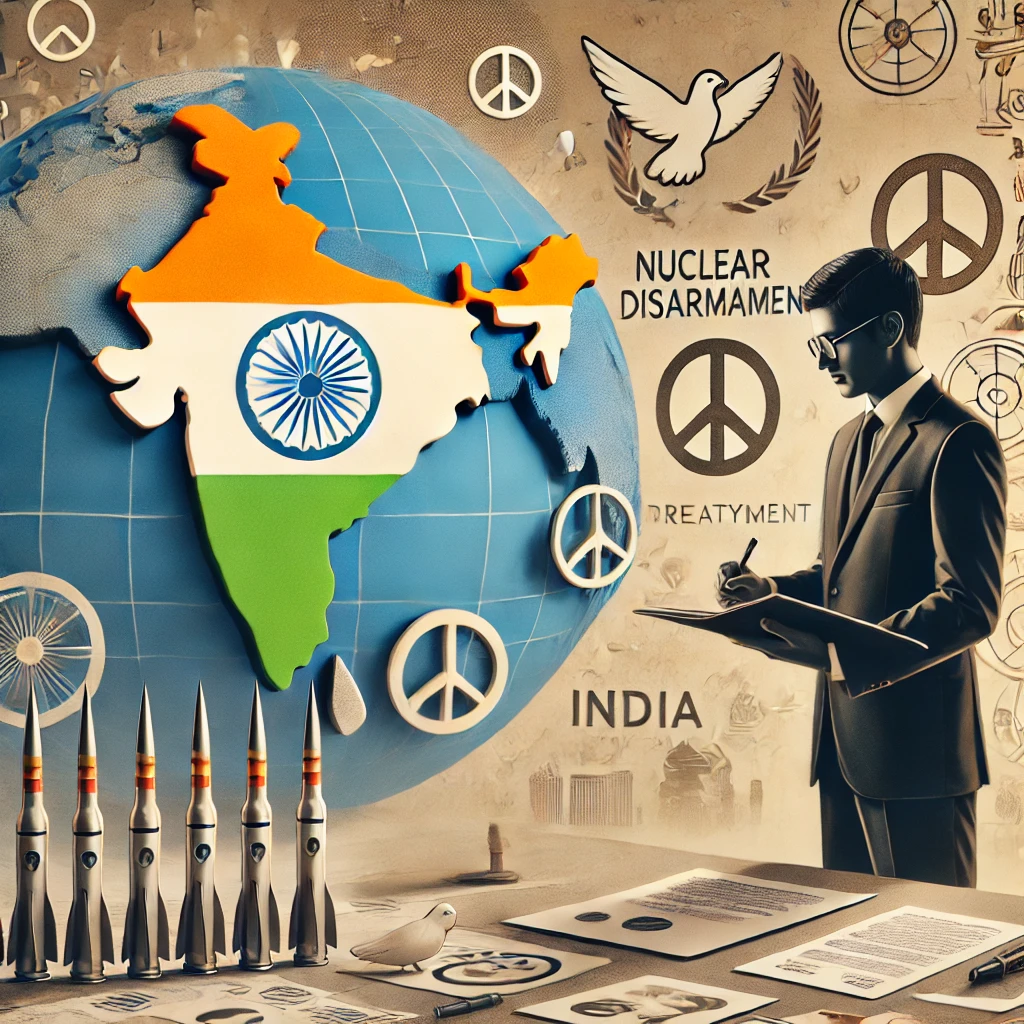India and Nuclear Disarmament reflects India’s long-standing commitment to global peace, advocating for a nuclear weapons-free world while balancing its security concerns. Marking the International Day for the Total Elimination of Nuclear Weapons on 26 September, it will look toward the Treaty on the Prohibition of Nuclear Weapons. Since 2021, this treaty has been meant to deliver a nuclear weapons-free world. On one hand, the TPNW has got positive traction, and contrarily, India’s status as a nuclear state outside the NPT frame presents difficult questions for New Delhi. National security through nuclear weapons now jostles with the potential of the TPNW to delegitimize such weapons.
| GS Paper | GS Paper III |
| Topics for UPSC Prelims | International Day for the Total Elimination of Nuclear Weapons, Non-Proliferation Treaty, International Atomic Energy Agency, 1963 Partial Nuclear Test Ban Treaty, Smiling Buddha, Comprehensive Nuclear-Test-Ban Treaty, Israel and Hamas, AI Supported Warfare, Submarine-launched ballistic missiles, Agni-V, Nuclear Suppliers Group, Agni-P missile. |
| Topics for UPSC Mains | Evolution of Global Nuclear Disarmament Efforts, Current Nuclear-Related Issues that India is Facing. |
Origin of the Article
This editorial is based on “Taking stock of global nuclear disarmament,” published in The Hindu on September 26, 2024. The article discusses the importance of the TPNW amidst global challenges and India’s nuanced position.
Relevance for UPSC Aspirants
Understanding this topic is vital for UPSC students as it covers significant aspects of international relations and security. It is directly related to the UPSC syllabus, enhancing their knowledge of global treaties, India’s foreign policy, and nuclear strategy, which are crucial for both Prelims and Mains.
Why in News?
The stand on TPNW by India is a very crucial nuance amidst the present efforts towards global nuclear disarmament. Such an argument needs to be supported with various instances and examples, establishing links to GS Paper 2 and 3 as a case of a balancing act for India outside the frame of NPT as a nuclear power. Previous UPSC questions have analyzed India’s nuclear policy, its role in disarmament treaties entered into with the global community, and that of national security amidst international efforts toward peace.

How Global Nuclear Disarmament Efforts Evolved Over Time
But the long and arduous journey toward global nuclear disarmament is a history of interminable ebbs and flows, of significant milestones and treaties aimed at reducing nuclear threats. Such geopolitical dynamics and technological changes have shaped efforts from the dawn of the nuclear age to recent disarmament initiatives.
Early Nuclear Era and First Disarmament Attempts (1945-1960)
The nuclear age opened with the 1945 Trinity test and the two subsequent bombings of Hiroshima and Nagasaki. The first Soviet nuclear test in 1949, however, began what is called the nuclear arms race. Early disarmament initiatives included the Baruch Plan and President Eisenhower’s “Atoms for Peace” initiative, leading to the formation of the International Atomic Energy Agency (IAEA) in 1957. At this stage, India, under Homi Bhabha, was a proponent of disarmament but began its first nuclear program in the 1950s.
Non-Proliferation Treaty and Partial Test Ban (1960-1970)
The 1963 Partial Nuclear Test Ban Treaty was, in fact, only to ban nuclear tests from being conducted above ground. The NPT was taken up in 1968, though it came into effect in 1970, was more ambitious as it targeted the spread of nuclear weapons by excluding five powers that had then already developed nuclear arms, counseling disarmament, and peaceful use of nuclear energy. India, perceiving the NPT to be discriminatory, refused to sign it while proceeding with its nuclear research, viewing the work as aimed at peaceful purposes.
SALT, START, and Regional Nuclear-Free Zones (1970-1990)
In the period, the US-USSR Strategic Arms Limitation Talks led to the 1972 Anti-Ballistic Missile Treaty and SALT I, which limited certain kinds of nuclear arms. A whole class of nuclear weapons was eliminated when the Intermediate-Range Nuclear Forces Treaty was signed in 1987. India held its first nuclear test, “Smiling Buddha,” in 1974 during this period.
Post-Cold War Disarmament Momentum (1990-2000)
Disarmament gained new momentum with the end of the Cold War. The START I, a 1991 Strategic Arms Reduction Treaty, already brought tremendous reductions in deployed nuclear warheads. The Comprehensive Nuclear-Test-Ban Treaty, CTBT, was opened for signature in 1996, but so far has not entered into force, as key states have failed to ratify it. In 1998, both India and Pakistan conducted nuclear tests, declaring themselves nuclear powers outside the NPT.
Challenges to Disarmament and New Initiatives (2000-2010)
In 2002, the US withdrew from the Anti-Ballistic Missile Treaty citing new threats. Global Threat Reduction Initiative was initiated in 2004 and targeted securing nuclear material all around the globe. India’s civil nuclear agreement with the US in 2008 automatically recognized its nuclear status while remaining outside the NPT, thereby reflecting the intricacies of global nuclear politics.
Humanitarian Initiative and Ban Treaty (2010-2020)
From the Humanitarian Initiative launched in 2010, focusing on the “catastrophic humanitarian consequences” of nuclear weapons, came the treaty in 2017 prohibiting nuclear weapons, which entered into force on January 22, 2021. Efforts to curb Iran’s nuclear program were headed toward success through a Joint Comprehensive Plan of Action of 2015, which the US withdrawal in 2018 challenged. India continued its call for universal disarmament while keeping the policy of “credible minimum deterrence.”
New Challenges and Uncertain Future (2020-Present)
Disarmament diplomacy was extensively disrupted by the COVID-19 pandemic. After more than a year of drama, in January 2021, both the United States and Russia ratified the extension of New START, the last big bilateral arms control treaty. Geopolitical tensions-from in Ukraine to the Israel-Hamas conflict-have heightened nuclear security worries. Newer technologies in the form of hypersonic weapons and AI-supported warfare are now new challenges to the strategic stability consensus.

Current Nuclear-Related Issues Faced by India
India has to deal with the whole range of present nuclear problems involving mixed strategic, diplomatic, and technological considerations. While persuading disarmament, they have to reconcile with deterrence, all against a pretty complex backdrop of regional geopolitics.
Balancing Nuclear Deterrence with Disarmament Advocacy
The South Asian nation maintains around 160 nuclear warheads and is presently developing its arsenal, including submarine-launched ballistic missiles (SLBMs) like the K-4. Even though India advocates universal nuclear disarmament, being an outside state of the NPT creates diplomatic tensions. This might mean making national security and international disarmament goals balance each other out, making its international position very complex.
Managing the China-Pakistan Nuclear Axis
The China-Pakistan strategic partnership enormously impacts the security of India. China backs the nuclear and missile development projects undertaken by Pakistan; these include missile technology and nuclear reactors like those installed at the Karachi Nuclear Power Plant. It increases regional tension. India has been countering this by developing longer-range missiles like the Agni-V and developing deterrent capabilities from its sea-based assets to hedge against an apparent two-front threat.
Nuclear Doctrine and No First Use Policy
Threats from tactical nuclear weapons by Pakistan and a growing arsenal by China necessitated this review of India’s No First Use (NFU) policy. That it would, indeed, realign the NFU stance for credible deterrence has been a matter of debate. The controversy over Indian officials’ claims of doctrinal shifts has sparked intense speculation that has affected regional stability and India’s diplomatic relations.
Nuclear Security and Safety Concerns
There is a need to ensure the highest safety principles in India’s constantly increasing nuclear infrastructure. There are 23 operational reactors and further plans for expansion. As shown by the Mayapuri radiation exposure accident in 2010, one cannot deny the vulnerability of the country. Despite international efforts toward nuclear security, there is a lack of confidence which can be seen in India’s position in the NTI Nuclear Security Index.
Civil Nuclear Cooperation and NSG Membership
Denial of full membership of the Nuclear Suppliers Group by China: An important issue in India’s incorporation into the global nuclear order is a denial of full membership of the Nuclear Suppliers Group by China, implying an inability on India’s part to take advantage of improved access to advanced technologies and the benefits that come with sharing in nuclear commerce. Agreements concluded with countries such as Japan are improvements, but these depend on arrangements peculiar to each country.
Technological Advancements and Strategic Stability
India’s developing nuclear and missile technologies–such as the Agni-P missile, now being armed with MIRVs–increases deterrence but risks unraveling the arms races in the region. Ballistic Missile Defense systems and their development, too, add strategic complexities requiring careful management to not destabilize the region.
Nuclear Energy Expansion and Environmental Concerns
Safety and environmentalist concerns are driving public opposition to increased nuclear power capacity in India. Protests have flared at the Kudankulam and Jaitapur projects. The drive for indigenous technology, such as the 700 MWe PHWRs, is advanced partly for reasons of pure technology independence from foreign technology import but meets with technical and economic roadblocks.

Measures India Can Adopt to Balance Nuclear Deterrence with Disarmament
There are several steps India can take in this respect, to balance nuclear deterrent power with advocacy for global disarmament; these underpin strategic stability, responsible stewardship, and technological advancement.
Strengthen Credible Minimum Deterrence (CMD)
India must reinforce its CMD posture more of the quality rather than the quantity. The K-4 test shows that credible sea-based deterrence is there. Pressing for more reliable and advanced systems than the mere number of missiles sustains deterrence while at the same time signaling restraint.
Promote Regional Strategic Stability Dialogues
India can begin discussing regional strategic stability with a focus on risk reduction and confidence. The regular meetings between India and Pakistan on nuclear risk reduction, such as between the United States and Russia, can help reduce tension improve crisis management, and demonstrate India’s commitment to regional stability.
Engage in Global Disarmament Initiatives
India must be proactive in international disarmament discussions, including the Conference on Disarmament. It could make a multilateral No First Use treaty an excellent extension of its policy. The fact that India is participating in Nuclear Security Summits and is an active participant in IAEA lays down again that India can take on leadership roles in disarmament.
Invest in Verification Technologies
Verification technologies are the way forward to disarmament. Any technology- space and satellites- developed and demonstrated by India through Chandrayaan-3, and others can be used to develop verification tools that can make India a critical component in global disarmament verification.
Strengthen Domestic Controls and Export Regulations
Such stewardship is ensured by the enhancement of domestic nuclear controls and export regulations. Strengthening security at the nuclear facilities, consolidating accounting of nuclear material, and tightening export controls over dual-use technologies will strengthen India’s non-proliferation credentials.
Promote Nuclear Energy for Sustainable Development
Nuclear energy is highly significant for the principles of sustainable development and can thus be used in support of the Indian program. Development of nuclear energy to advanced reactor designs, including the AHWR featuring a thorium fuel cycle, addresses both peaceful nuclear technology and climate goals for India.
Engage in Track 1.5 and Track 2 Diplomacy
After all, involvement in Track 1.5 and Track 2 initiatives could complement efforts at the official level. Hosting regional workshops on nuclear risk reduction, again inspired by the Stability-Instability Paradox workshops, would serve not only to develop relations but to delineate opportunities for innovation and gain entry into disarmament discourse. India would thereby well balance nuclear deterrence policies with disarmament obligations globally, further underlining its responsible nuclear state status.
PESTEL Analysis
| Political: India faces diplomatic challenges in balancing its nuclear deterrence while advocating for global disarmament. Geopolitical tensions with China and Pakistan complicate its stance on the Treaty on the Prohibition of Nuclear Weapons (TPNW), as India continues to prioritize its national security. Economic: India’s investments in modernizing its nuclear arsenal, including submarine-launched ballistic missiles, carry significant economic costs. Simultaneously, India seeks to expand nuclear energy capacity to reduce reliance on fossil fuels, thus addressing environmental concerns and energy needs. Social: Public opposition to nuclear energy expansion, due to safety and environmental concerns, poses a challenge. The focus on safe nuclear infrastructure is crucial, with incidents like the 2010 Mayapuri radiation exposure highlighting vulnerabilities. Technological: India is advancing its nuclear capabilities with technological developments such as the Agni-V and Agni-P missiles. These innovations enhance deterrence but raise the risk of triggering an arms race, especially in the context of its regional rivals. Environmental: Nuclear energy is a key part of India’s sustainable development strategy, offering a clean energy source to meet rising demands. However, environmental concerns over nuclear waste and potential disasters continue to pose challenges to wider adoption. Legal: India’s exclusion from the Non-Proliferation Treaty (NPT) and the Nuclear Suppliers Group (NSG) creates legal barriers to accessing global nuclear markets. Despite this, India continues to seek full NSG membership and adheres to global nuclear security initiatives. |
Conclusion
The challenge for the nation is bound to be arduous, as it would face a tightrope balancing act between national security needs and disarmament interests at the global level. Strengthening its deterrence capabilities and promoting nuclear disarmament through international diplomacy. Applying beneficial peaceful uses of nuclear technology should help India steadily emerge as a responsible nuclear power. This dual approach would not only protect national interests but also contribute toward worldwide peace and stability, encouraging further civil servants to handle the equal gauntlets with subtlety and strategic foresight.
| UPSC Civil Services Examination, Previous Year Questions (PYQs) Mains Q. India’s refusal to sign the Comprehensive Nuclear-Test-Ban Treaty (CTBT) has been criticized by several nations. Critically evaluate India’s stance on the CTBT in light of its national security and global nuclear disarmament objectives. (UPSC GS Paper-II, 2022) Q. Trace the evolution of global nuclear disarmament efforts since the Cold War. How have treaties like the Non-Proliferation Treaty (NPT), the Comprehensive Nuclear-Test-Ban Treaty (CTBT), and the Treaty on the Prohibition of Nuclear Weapons (TPNW) contributed to this movement? Critically analyze the reasons for the limited success of these efforts. |



